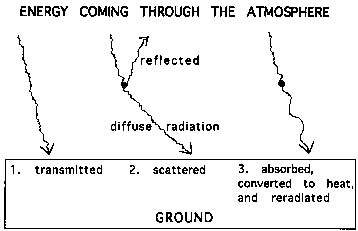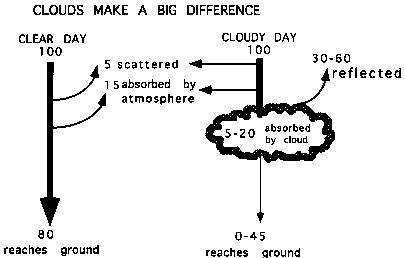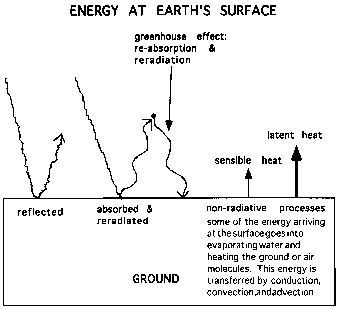Notes: Wed 18 Sept
The Radiation Budget
The radiation budget tracks what happens to solar energy on the way down to Earth, through the atmosphere, and back up from Earth.
It balances the input (mostly visible and infrared radiation) with the output.
How do we know the budget is balanced on a global scale?
Because if it were unbalanced, then the temperature on Earth would either go way up or way down over time.
Since our temperature is pretty stable, that shows that the budget is balanced.
On a shorter timescale like hours or days, the budget may not always be balanced. The budget also varies by latitude. The equator is always going to
get more energy than the poles, for instance.
albedo: the reflectivity of a surface.
High albedo materials reflect a lot, such as a white surface.
Both clouds and glaciers are very reflective and bright when light strikes them.
Clouds are the single most important factor in the albedo of the Earth.
Glaciers are also important.
Albedo can change quite a bit.
Roughness of a surface is also a factor (rough surfaces scatter and reflect light better).
Of the solar radiation that enters Earth's atmosphere, some portions are...

- transmitted to Earth's surface (without running into any particles on the way; wavelength stays the same)
- scattered (wavelength stays the same)...
- back out to space by gas, dust, and clouds (reflection)
- down to the ground by gas, dust, and clouds (diffuse radiation)
- absorbed by gas, dust, and clouds, then converted to heat and reradiated at longer wavelengths.
Refraction, or the bending of light, is another change that incoming radiation can experience.
It is responsible for rainbows and mirages.
But it really is only important at daybreak and twilight:
refraction lengthens the day a little bit by bending the sun's rays over the horizon after the sun has actually set.
overhead: energy flux on the surface of the Earth
The subsolar point gets the most direct light, and the equator is pretty close to the subsolar point at all times of the year.
It also has 12 hours of sunlight every day.
So why doesn't the equator get the most incoming energy?
Remember that it rains a lot in the tropics, and to rain you need clouds.
Well, clouds have a high albedo and therefore reflect very well.
Therefore the incoming radiation will be lowered because the clouds reflect a lot of energy away.
In contrast, the desert regions just outside the tropical latitudes are very dry and have practically no clouds.
As you'd expect, they typically have the highest incoming solar radiation.

Of the radiation that makes it to Earth's surface, some portions are...

- reflected back into space (not much)
- absorbed and reradiated at longer wavelengths...
- back into space or into clouds (which go on to radiate that energy back into space)
- into the atmosphere and back down to Earth. This process is called the Greenhouse effect.
- taken up by non-radiative energy transfer, such as...
- *latent heat*, which is the energy content of a body due to its molecular or atomic bonding.
It is involved in melting/freezing or evaporation/condensation.
- sensible heat, the energy content of a body related to its kinetic energy (commonly, the thermal temperature)
The transport of latent and sensible heat is mechanical (as opposed to radiative).
Three types of mechanical heat transport are:
- *convection*: vertical transfer of heat through physical motion of particles
- advection: as above, but with strong horizontal motions
- conduction: molecule to molecule transfer of heat
(non-radiative part adapted from Dr. Stearns' handout of 20 Sept. *'s indicate the more important items)
Note here that the Greenhouse effect does occur naturally.
Without it, the Earth would be pretty cold and uncomfortable.
CO2 is a good Greenhouse gas, meaning that
it is good at absorbing energy radiated from the ground and reradiating that energy back down to Earth.
There is a man-made Greenhouse effect. It is the speeding up of the natural Greenhouse effect due to humans putting more Greenhouse gases in the atmosphere.
Back to GS 201 homepage



